
25 minute read
Chapter III: White Spots
Introduction........................................................................................................... What is Happening?....................................................................................... The Urban Take Over........................................................................................ De-urbanization................................................................................................... White Spots............................................................................................................ NDSM and similar projects.......................................................................
This city is alive (Don’t get too close or she’ll break your heart)
Advertisement
This city is alive This city is alive And if you don’t believe it, Inhale and hug her to your chest Feel the reverberations of her Heartbeat in your stomach She’s a pulsing beating quivering thing And with every footstep That echoes through her hollowed alleyways, Cobblestoned hideaways, She learns
This city makes no promises And there’s deceit in her mischievous eyes But the pull of her paradise lips to your own is magnetic She slams the strongest men To their knees
- Savannah Brown
Introduction
There is a lot of construction happening in the world, especially in big cities like Chicago. Yet, this is not just an American trend, as more and more people around the world are willing to live, work and recreate in the cities, the demand for real estate rises.
This trend naturally results in an increase in property prices. For the first time in history, more people are living in the cities and it doesn’t look like this trend would be coming to an end in the foreseeable future. As a city grows, it needs new dwellings, new opportunities for its residents to help keep the city alive and help it reinvent itself.
An important question would be: how do our cities want to grow, and who will they host? Should large cities like Chicago only allow corporates and big scale businesses to survive? Or does every city need different groups and talents to stay desirable in the long run? It seems like big developers only look at big cities as a ground to make profits, but is that how we want our cities to be? Does the highest bidder always have to win? Or should everyone be given a chance to create in a city without being pushed out because of their economic status?
These are all important arguments to introduce a new system in cities, a system that does not cost much uses existing facilities as much as possible, and belongs to individuals and groups who keep the city alive.
What is Happening?
Illustration: Hilary Koob-Sassen https://www.theguardian. com/cities/2015/dec/23/ monster-city-urban-fairytalesaskia-sassen
Illustration The city moving forward across the centuries
A Monster Crawling in the Cities
Cities have been around for thousands of years. To be more precise, historians believe cities came into existence somewhere between 8,000-10,000 years ago, and some scientists believe the first cities came into existence around 7,500 B.C. in Mesopotamia.
Therefore, the idea of cities is not new, not at all. As a matter of fact, mapping research released at World Urban Forum 10 in 2020 concluded that today, there are more than 10,000 cities in the world, half of which born in the last 40 years. In another research, The United Nations states that by the year 2000, there were 371 cities in the world with 1 million inhabitants or more.
This number grew to be 548 in 2018 and it is expected that by 2030 there will be 706 cities with at least 1 million people living in them. How are these cities existing? Is it the power of gold, banks, and organizations or is it people, groups, and neighborhoods?
Kings and queens have lived and died, banks and organizations rise, go bankrupt and new ones take their places. But it is always the people who keep the city alive during good and bad times. They might not always be rich, but history has proven that they are good at making neighborhoods; with lots of small shops, churches, theatres, and craftspeople working with different materials. Streets that walking through them gives observers a certain high. A high with shops and pubs and people moving in and out. Streets and neighborhoods together create the urban tissue.
https://www.theguardian. com/cities/2015/dec/23/ monster-city-urban-fairytale-saskia-sassen
https://www.theguardian. com/cities/2015/dec/23/ monster-city-urban-fairytalesaskia-sassen But, there are strange things happening in our cities, especially the larger ones which are more appealing to people with loads of money to spend. It is an explosion that looks like a firework of large buildings; buildings that look different, yet all tall and grand.
This might sound interesting at first, but it gets scary when we learn these fireworks are happening in long-standing dense, and lively neighborhoods where people have lived and made for decades and centuries.
Areas and structures are flattened to make room for tall, often single-purpose towers, wiping the history and atmosphere of what used to stand beneath their concrete and steel frame. People know it is impossible to have a city without neighborhoods, yet this monstrous explosion does not listen, it goes on destroying people’s houses, shops, and the squares in their neighborhoods.
As this monster keeps on moving and ripping the city tissue, there will not be places for people to live and create anymore. As this firework of tall buildings gets scattered everywhere, everywhere becomes nowhere.
Illustration It was as if a monster had crawled into the city

:Illustration Hilary Koob-Sassen https://www.theguardian. com/cities/2015/dec/23/ monster-city-urban-fairytale-saskia-sassen
The Urban Takeover
One thing in common between cities: they are all complex yet incomplete systems. How cities have outlived far more powerful, formalized systems is woven in that characteristic. All major cities, including Chicago, New York, Shanghai, London, and Tehran to name a few, have outlived multiple types of rulers and businesses.
What cities make possible is for the powerless to leave a footprint, footprints that together show the city is theirs too. These cultural, economic, and social imprints are usually left behind in the neighborhoods, which eventually spread to larger urban zones. All of these could only happen organically, in spaces that belong to the people.
One cannot create a private business park targeting low-income population, no matter how dense, and wish for this sort of “making” to happen again, those are only places to “work”; at best.
As Saskia Sassen puts it: “It is only in cities where that possibility of gaining complexity in one’s powerlessness can happen – because nothing can fully control such a diversity of people and engagements”.
https://www.theguardian. com/cities/2015/nov/24/ who-owns-our-cities-andwhy-this-urban-takeovershould-concern-us-all
Created by: @overview Imagery: @nearmap https://www.archdaily. com/957935/ vertical-urbaniza tion-as-seenfrom-above/6038db75f91c814395000007-vertical-urbanization-as-seenfrom-above-image
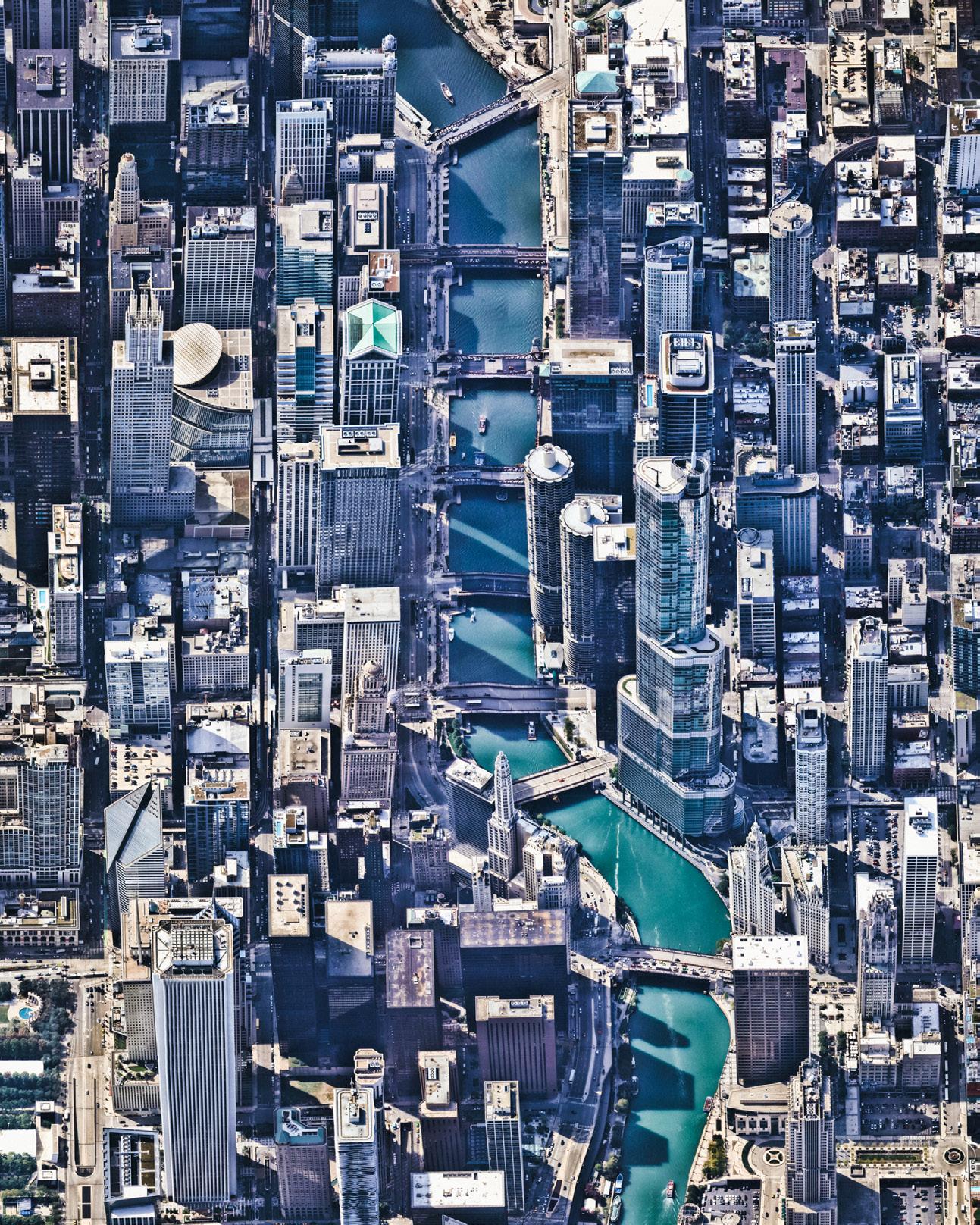
Aerial view of Chicago
Post-2008 Urban Investment
In an article called “Who owns our cities – and why this urban takeover should concern us all”, Saskia Sassen goes over features in the new phase of urban investment surge which has been happening since 2008. A trend in which large companies and corporations, national and foreign, have started purchasing large-scale lands in major cities. Based on her observations there are four features that stand out the most:
- The sharp scale-up in the buying of buildings: Nowadays investors from countries such as China are major buyers in cities like New York and London. Foreign corporate buying has seen increases of up to 475% and 248% in cities like Nanjing and Amsterdam/Randstadt respectively.
- The extent of new construction: In contrast with the trends in the 1980s and 90s which were about owning existing buildings, the current trend is focused on the destruction of buildings and replacing them with much taller, luxurious offices and apartments.
- The spread of mega-projects with vast footprints: Structures that kill much of the urban tissue. Mega-projects increase the density of the city, while actually de-urbanizing it. Highlighting an overlooked fact: density is not enough to have a city.
- The foreclosing on modest properties: owned by modest-income households. For example in the US, the federal reserve data shows that more than 14 million households lost their homes between 2006 and 2014.
https://www.theguardian. com/cities/2015/nov/24/ who-owns-our-cities-andwhy-this-urban-takeovershould-concern-us-all
After the economic crisis of 2008, the world and specifically large cities have since experienced a new trend: big corporates buying big chunks of cities and buildings.
In the market of large land and building acquisitions (for example purchases of a minimum of $5m in the case of New York City), $600bn was spent by corporates to buy a building in the top 100 recipient cities between mid-2013 and mid2014.
This number rose to be $1 trillion the next year. From this number, $20bn was spent in Chicago, making it sit Seventh in the rankings; New York, London, and Tokyo being the top Three.
https://www.theguardian. com/cities/2015/nov/24/ who-owns-our-cities-andwhy-this-urban-takeovershould-concern-us-all These figures only include buildings that were acquired and exclude another major trend, site development. This worrying trend can only mean one thing; less space available to the public, and more corporate headquarters, luxury apartments, and malls.
A Cushman & Wakefield Capital Markets Research Publication
INVESTMENT VOLUMES
Investment volumes in top recipient cities compared to previous 12 months Table 4: TOTAL INVESTMENT VOLUMES
(EX DEV. SITES)
METRO
1 New York Q3 2014 – Q2 2015 (US$) GROWTH*
74,799,870,615 36.3%
2 London
3 Tokyo
4 Los Angeles
5 San Francisco 55,206,679,357 13.4%
37,971,179,153 0.7%
37,457,376,509 14.4%
32,355,485,613 35.9%
6 Paris
7 Chicago
8 Washington, D.C
9 Dallas
10 Atlanta
11 Miami 22,955,312,136 -0.2%
20,036,200,994 39.4%
18,515,548,212 29.5%
16,296,780,618 13.4%
16,022,394,226 60.7%
15,949,703,541 74.5%
12 Boston
13 Hong Kong
14 Sydney
15 Houston
16 Berlin
17 Seattle
18 Melbourne
19 Frankfurt
20 Phoenix
21 Denver
22 Austin
23 Shanghai
24 Amsterdam
25 Munich 15,365,776,426 43.2%
14,447,415,389 4.9%
14,075,615,656 7.9%
12,365,902,892 -6.2%
11,814,090,834 -6.2%
11,609,540,148 31.9%
11,078,147,297 33.1%
9,845,334,528 38.0%
9,312,751,061 53.5%
9,029,533,977 19.6%
8,046,028,787 45.3%
7,978,366,830 -19.6%
7,942,738,059 13.3%
7,271,540,067 9.9% 26 San Diego 27 Madrid 28 Orlando 29 Stockholm 30 Hawaii 31 Osaka 32 Hamburg 33 Toronto 34 Singapore 35 Beijing 36 Brisbane 37 Philadelphia 38 Seoul 39 Nanjing 40 Minneapolis 41 Raleigh/Durham 42 Charlotte 43 Tampa 44 Portland 45 Milan 46 Dublin 47 Oslo A Cushman & Wakefield 48 Manchester Capital Markets Research Publication: Winning in growth cities 2015/2016 49 https://smart-lighting. es/wp-content/ San Antonio uploads/2015/10/Winning50 Birmingham (UK)in-Growth-Cities-20152016-PDF.pdf
*Compared to previous 12 months. Source: Cushman & Wakefield, Real Capital Analytics
TOP 25 CITIES FOR GLOBAL PROPERTY INVESTMENT (EX DEV. SITES, Q3 2014 – Q2 2015)
80
70
60 New York
De-urbanization
Cosmopolitanism: The idea that all human beings are, or could be or should be, members of a single community. Different views of what constitutes this community may include a focus on moral standards, economic practices, political structures, and/or cultural forms.
-Pauline Kleingeld, Eric Brown
Global geographies of extraction have long been key to the western world’s economic development. And now these have moved on to urban land, going well beyond the traditional association with plantations and mines, even as these have been extended and made more brutally efficient.
The corporatizing of access and control over urban land has extended not only to high-end urban sites but also to the land beneath the homes of modest households and government offices. We are witnessing an unusually large scale of corporate buying of whole pieces of cities in the last few years. The mechanisms for these extractions are often far more complex than the outcomes, which can be quite elementary in their brutality.
One key transformation is a shift from mostly small private to large corporate modes of ownership, and from public to private. This is a process that takes place in bits and pieces, some big and some small, and to some extent, these practices have long been part of the urban land market and urban development. But today’s scale-up takes it all to a whole new dimension, one that alters the historic meaning of the city.
This is particularly so because what was small and/or public is becoming large and private. The trend is to move from small properties embedded in city areas that are crisscrossed by streets and small public squares, to projects that erase much of this public tissue of streets and squares via mega-projects with large, sometimes huge, footprints. This privatized and de-urbanized city space no matter the added density.
Large cities have long been complex and incomplete. This has enabled the incorporation of diverse people, logic, politics. A large, mixed city is a frontier zone where actors from different worlds can have an encounter for which there are no established rules of engagement, and where the powerless and the powerful can actually meet.
https://www.theguardian. com/cities/2015/nov/24/ who-owns-our-cities-andwhy-this-urban-takeovershould-concern-us-all
https://www.theguardian. com/cities/2015/nov/24/ who-owns-our-cities-andwhy-this-urban-takeovershould-concern-us-all This also makes cities spaces of innovations, small and large. And this includes innovations by those without power: even if they do not necessarily become powerful in the process, they produce components of a city, thus leaving a legacy that adds to its cosmopolitanism – something that few other places enable.
But today, rather than a space for including people from many diverse backgrounds and cultures, our global cities are expelling people and diversity. Their new owners, often parttime inhabitants, are very international – but that does not mean they represent many diverse cultures and traditions. Instead, they represent the new global culture of the successful – and they are astoundingly homogeneous, no matter how diverse their countries of birth and languages. This is not the urban subject that our large, mixed cities have historically produced. This is, above all, a global “corporate” subject.
Much of urban change is inevitably predicated on expelling what used to be. Since their beginnings, whether 3,000 years old or 100, cities have kept reinventing themselves, which means there are always winners and losers. Urban histories are replete with accounts of those who were once poor and quasi-outsiders, or modest middle classes, that gained ground – because cities have long accommodated extraordinary variety.
But today’s large-scale corporate buying of urban space in its diverse instantiations introduces a de-urbanizing dynamic. It is not adding to mix and diversity. Instead, it implants a whole new formation in our cities – in the shape of a firework of high-rise luxury buildings.
Examples of Chicago Mega-Projets Currently in the Works
Riverline and South bank A $2bn project transforming 14 acres of vacant land, created by Perkins + Will
The River District 14 mixed-use buildings to be built on 30 acres of land, creating offices and residential units
One Central A $20bn project across 34 acres of land including “multi-purpose” towers and train stations
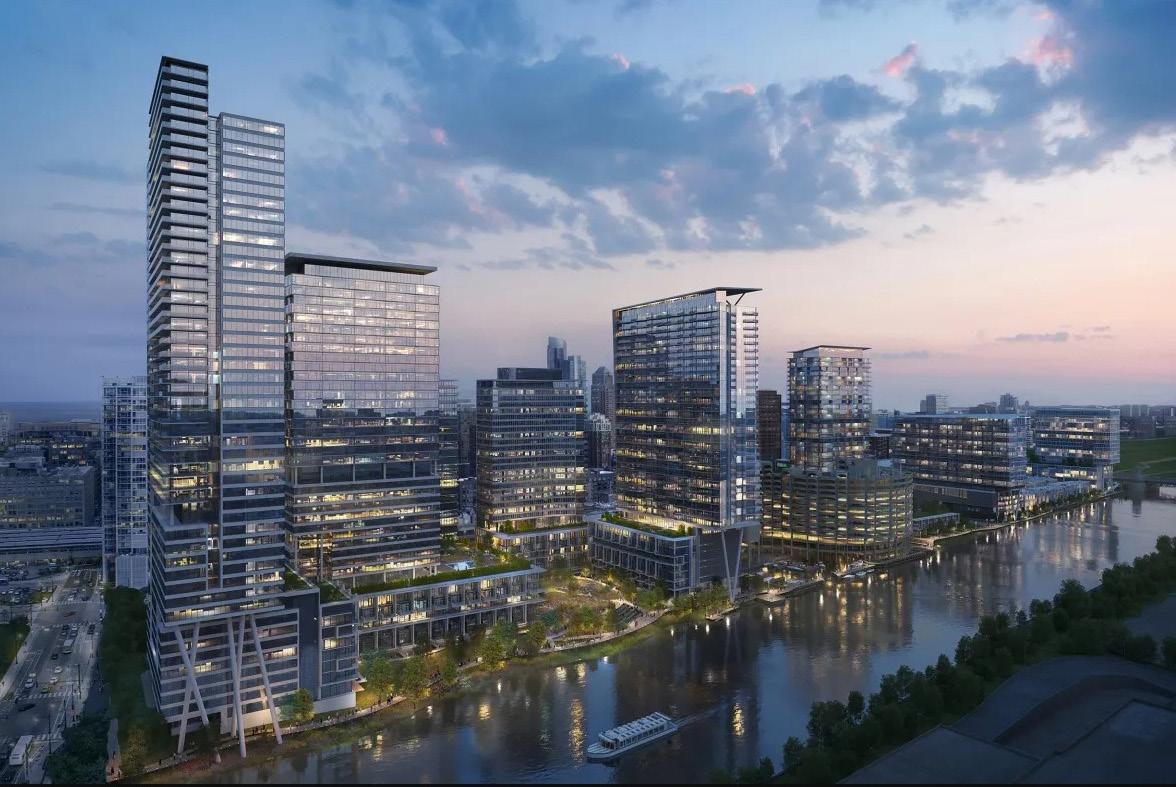
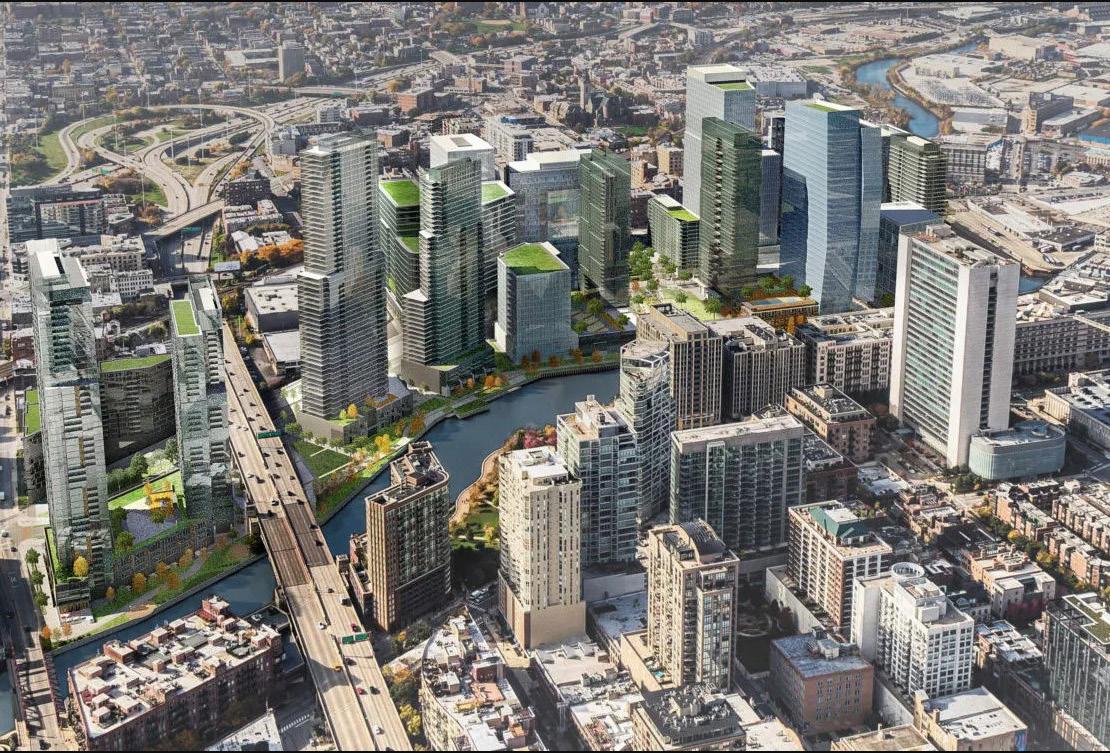
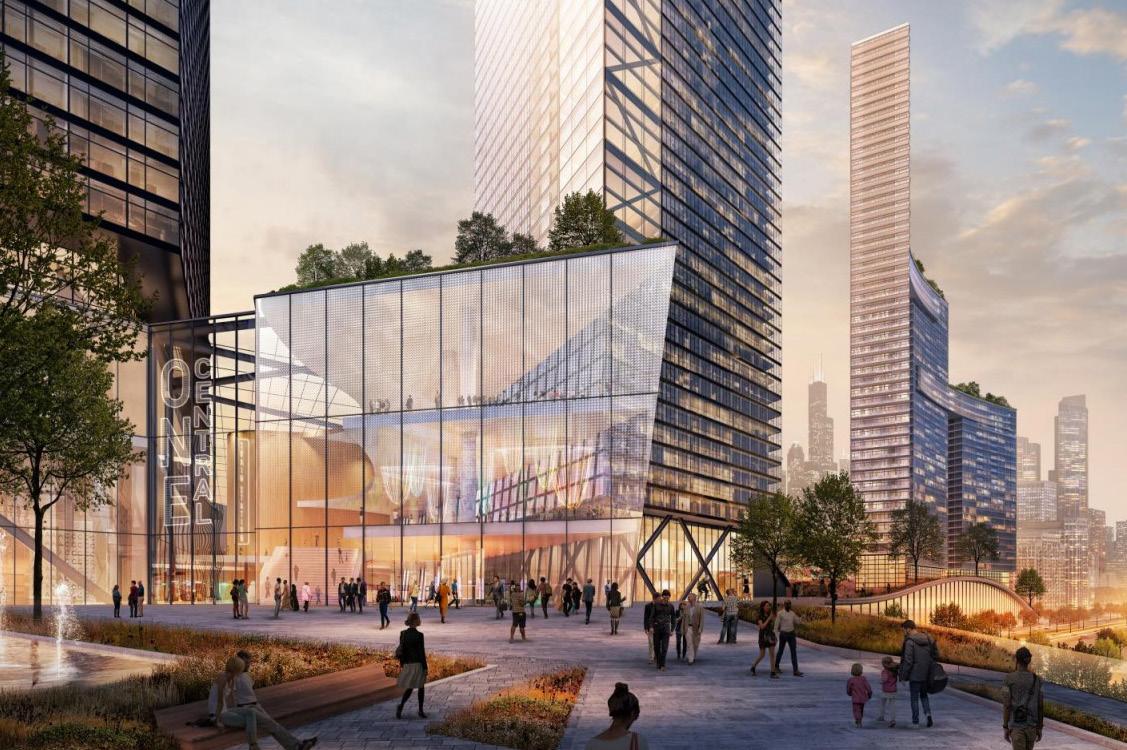
https://chicago. curbed.com/maps/ chicago-developments-lincoln-yards-78-one-central
https://chicago. curbed.com/maps/ chicago-developments-lincoln-yards-78-one-central
http://ward03chicago. com/wp-content/uploads/2019/03/ONE-Central-Town-Hall-31319.pdf
White Spots
Alternative Ways of Urban Development
Make your city, Eva De Klerk p. 23-25 The philosophy of De Stad als Casco was conceived in Amsterdam in the mid1990s. Although it did not attract a wide audience at the time, it has now become very topical.
The concept was introduced by a group of squatters, artists, and professionals in the fields of urban development, housing, and architecture for a reason. At Amsterdam, the city wanted to renew the strip along the south bank of the river IJ that comprised former port and industrial buildings. This era was also a turning point for Amsterdam, as investments flooded into the city and well-known squats were cleared, the property price started climbing.
As a result, living in the city became more popular yet, the financially vulnerable group started suffering the consequences. Therefore, they started moving to abandoned industrial sites in the port area, refurbishing and reusing old heritage buildings.
The new developments and also the threat posed to such sites raised questions about the livability of the city center and if pushing financially vulnerable creatives out was the right move. This led a group to try and find alternative ways of development, leading to the manifesto of De Stad als Casco.
The Philosophy of De Stad als Casco | City as a Shell
The manifesto implies using the existing city as a point of departure. To give buildings that are already standing a new use, as it has been the case through the centuries. The authors of De Stad als casco believed existing properties have a “characteristic idiosyncrasy”.
It’s these buildings and structures that give an area its soul which is almost impossible to recreate during new developments. Also, demolition and new construction are neither environmentally nor socially sustainable.
They believed people should be taken to the next stage of development instead of getting pushed away. Then over time, existing buildings can attract new users and it’s the new users who would bring additional functions in an organic way.
In this way of thinking, it is important to develop ideas based on existing structures and users. Since given the opportunity and space, people and creatives can create a world of their own. The important factor is to avoid developing areas by outsiders, ditching the common top-down view and replacing it with a bottom-up one.
By developing with the method of De Stad als Casco, residents and users design their own space or have someone else do it for them. The “shell” would be the framework; the world inside the framework can change, depending on the user and the function.
Make your city, Eva De Klerk p. 25.
The Role of Initiators vs Traditional Top-down Management
Social Advantages
Make your city, Eva De Klerk P. 177-181 Municipalities, housing associations, and private property owners all want to own a charismatic hotspot. What they do not know is that instead of drawing up billion-dollar plans to wipe and re-construct large urban areas, they only need to find creative groups who are willing to invest their time into existing infrastructure and find a new use case.
Based on Eva De Klerk’s experience they are normally aiming for a temporary project with an end result in mind. Municipalities and property owners find it hard to let go of traditional top-down principles of management.
As a result, not willing to let a group be in charge. Oftentimes, it is also hard for them to understand that it is impossible to copy one principle from a project to one another since every site has its own context, that success is only achieved when a group of people works together intensively and consistently. In other words, the more freedom people have in decision-making, the higher the chances of success.
Make your city, Eva De Klerk p. 221 SER study: https://www.ser. nl/nl/publicaties/passie-gewaardeerd The SER study reaffirms the added value of people working in the cultural and creative sectors. This is important because collectively, they hardly benefit at all. The philosophy of de stad als casco includes the idea that any value increase should be distributed fairly, rather than benefiting only a small group of people.
It also advocates a broader understanding of value, one that is not only based on money. Literally quoting the 1997 book De stad als casco II:
“the approach of de stad als casco is based on human interaction rather than on major capital investments that make continuation of existing use impossible. Powerful investment flows are lost when the efforts and services of people are not considered investments. Gradual and area oriented development award these investments a lasting value and this is to the advantage of both the collective and the individual. Thus, all returns on investments consist of both money (objective) and a high-quality living environment (subjective). An area developed in accordance with the philosophy of de stad als casco has a positive emotional value to various users and thus provides a high-quality public domain.”
The Pressures Facing Self-Employed Creatives
Artisans, creative makers, and artists are all entrepreneurs. Why would any government help them realize more affordable working and living spaces, whether in the context of self-rule or any other?
Eva de Klerk thinks of a number of reasons. The study ‘Passie gewardeerd’ (passion is valued) published by the Sociaal Economische Raad (SER) and the Raad van Cultuur (the social-economic council and the culture council) shows that individual cases expected, the income position of the self-employed in the creative sector leaves much to be desired.
That in itself is worrying, but it becomes even more distressing in the light of the researchers’ conclusion that it is precisely these creatives that add value to the urban economy, though they hardly take advantage of it themselves. Other parties, such as property owners, pick up the profits as they see the value of their buildings rise. These are the very same buildings that are (in danger of) becoming unaffordable to self-employed creatives.
These are reasons that justify facilitating the creation of affordable living and working space for this group, for example by reducing land prices.
Make your city, Eva De Klerk p. 221 SER study: https://www.ser. nl/nl/publicaties/passie-gewaardeerd
17th-century Amsterdam as a Source of Inspiration
Make your city, Eva De Klerk p. 245-247 The idea to build hofjes for the poor was conceived during the ‘Vierde Uitleg’, Amsterdam’s fourth city extension that was realized around 1660 and included two new islands exclusively dedicated to ‘good works’.
The islands are located between the Amstel River and Plantage Muidergracht, and between Nieuwe Herengracht and Nieuwe Prinsengracht. The city of Amsterdam not only took responsibility for the city extension as a whole but also for the construction of the two islands, including their infrastructure.
Subsequently, private individuals could use the land to perform good works, which they financed out of their own pockets. As a result, the islands accommodate a cluster of alms-houses founded by, among others, wealthy Amsterdam families. Examples that still exist are Amstelhof (which now houses the Hermitage), Corvershof, Wittenberg, and the Sar- phatihuis. The latter was originally built as a municipal workhouse.
The ‘good works’ targeted people that did not have the means to organize their own accommodations or facilities. The better-off realized that these people nevertheless deserved a place in the city. To make sure that these socially important initiatives would continue to exist for generations, each hofje had a statute that made it effectively impossible to change its use. The hofjes were managed by the famous regents of Holland and by volunteers from the upper classes. That means that ever since the townspeople can count on the guaranteed use of these facilities.
No matter how rich the city becomes, the hofjes can never be discontinued on account of commercial interests. On the contrary, the two simply exist side by side.
Left: https://nl.wikipedia.org/ wiki/Nieuwe_Herengracht Right: https://nl.wikipedia. org/wiki/Wittenberg_(Amsterdam)
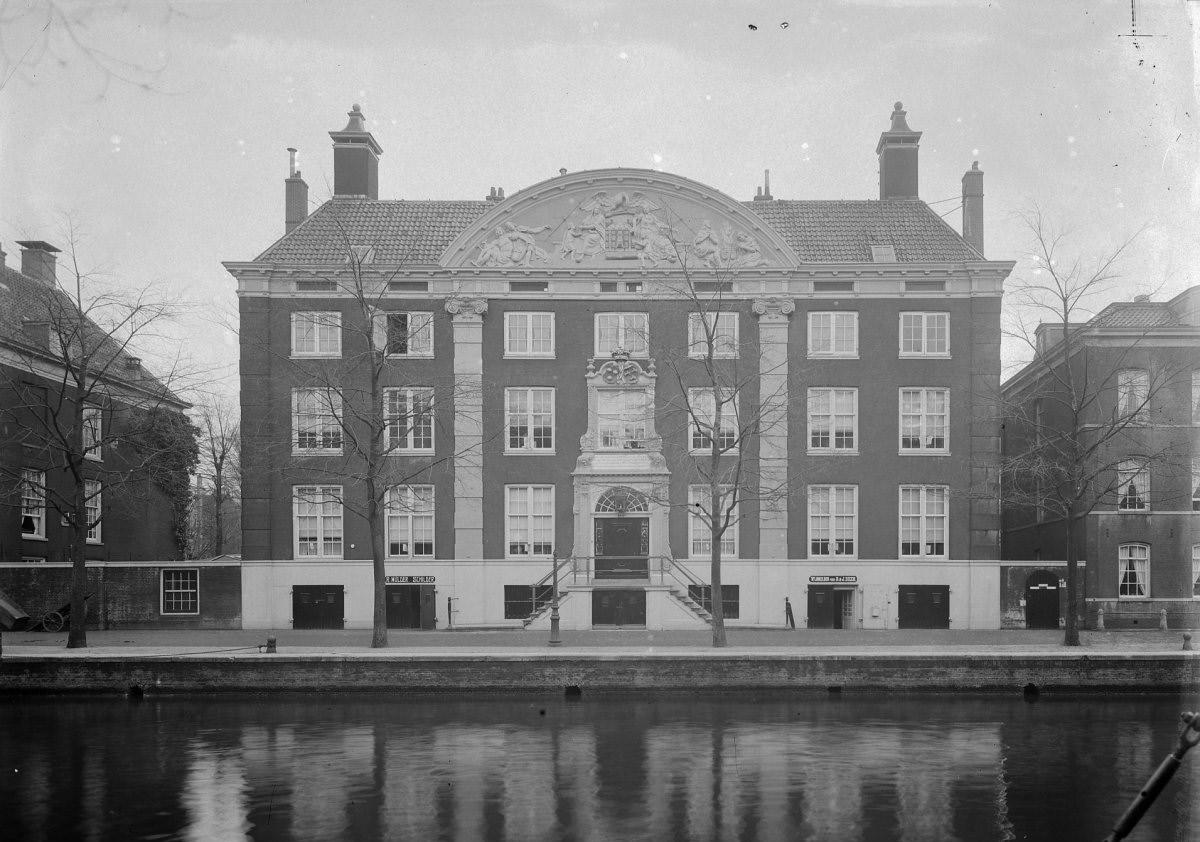
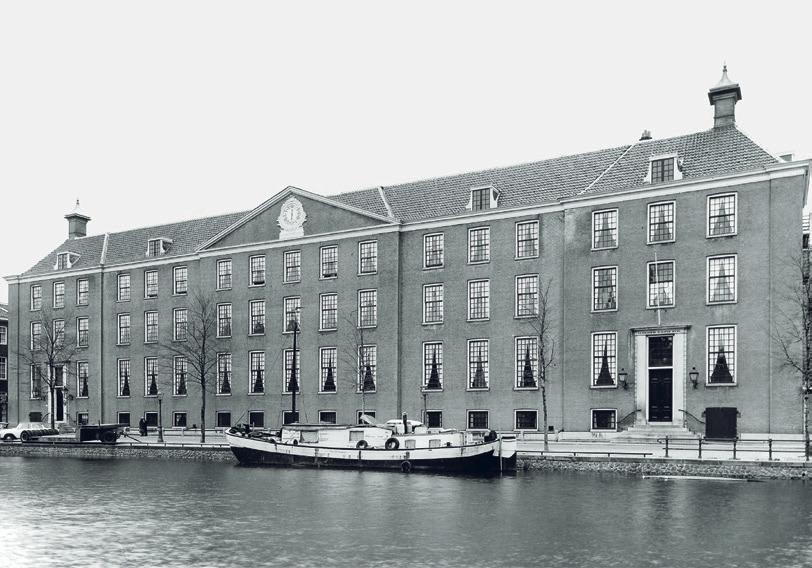
White Spots Plan
As the economy is picking up, we have the room and financial scope to experiment with alternative forms of urban development. Areas can be designated “transition zones” or “low-rule areas” in which final allocations remain unestablished.
They would have room for experiments with all forms of use; successful initiatives could be continued and the efforts and investments of initiators and users preserved. In addition, unlike governments or property developers, the latter are capable of using community building and crowdfunding to hold on to committed financiers.
The investments of initiators that are only allowed to set up temporary projects today will have more quality and become more sustainable once they know that they can commit to an area for a longer period of time.
In addition to allowing other kinds of collaborations, for example, participation companies, it is important for local authorities to include ‘white spots’ in their zoning plans. What we need is a White Spots Plan, a map of urban areas reserved for alternative ways of urban development, beyond the market economy.
Make your city, Eva De Klerk p. 241-245.
White Spots Plan An incremental urban development plan: temporary initiatives that are successful and have a distinctive identity are included in the subsequent development of the area or given the option to continue at a different location.
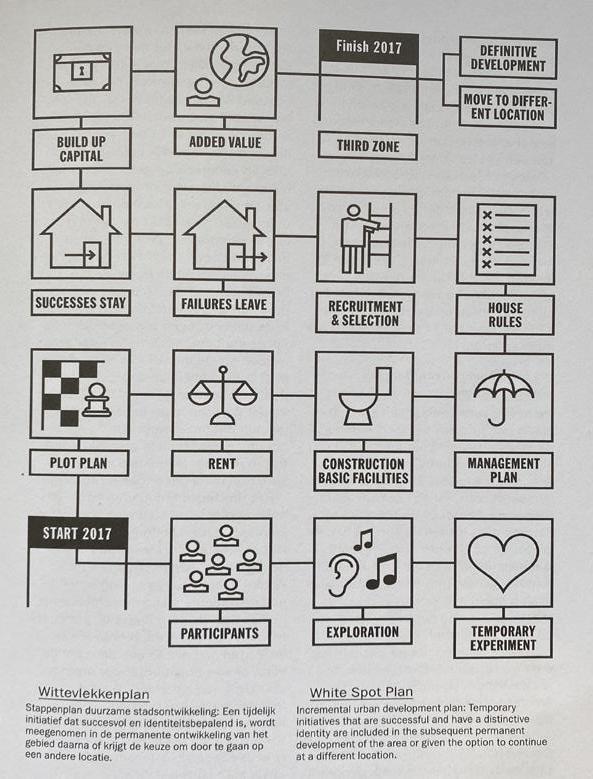
Make your city, Eva De Klerk p. 243.
Towards NDSM
Make your city, Eva De Klerk The abandoned shipbuilding warehouse of the NDSM (the Dutch Shipbuilding and Dry dock Company) shipyard on the north bank of the IJ was the first property that was revived using the method of De Stad als Casco. A building that is currently the largest self-organizing creative workspace in Europe.
The tale of NDSM starts with a familiar situation. A big city that was once affordable for everyone starting to get more expensive, pushing the low-income population out. At the same time, they were squatting communities occupying abandoned buildings in and around the city. One of these communities had shaped in the old shipyard area in Amsterdam Noord.
Yet, during the 1990s the city wanted to create a modern business center in the area in hopes of turning it into a desirable business district for large corporates. The reason behind this decision was that Amsterdam at the time was losing a lot of its economic importance. As a result, Rem Koolhaas was commissioned to make up plans for the idea and, naturally, he came up with a state-of-the-art office district with brand new cultural facilities and hundreds of luxury owner-occupied and rented houses.
In the end, the plan nicknamed “Manhattan on the IJ” did not go through, since it was contrasting with the city’s image, and also sponsors chose another area for development. Still, a lot of buildings in the area got destroyed. Later, following years of effort which are out of context in this paper, Eva De Klerk and a group of artists, makers, and creators who were willing to invest and work at NDSM successfully bought one of the shipyards and keep it from getting demolished.
Images Showing the past and current state of the NDSM shipyard located in Amsterdam Noord
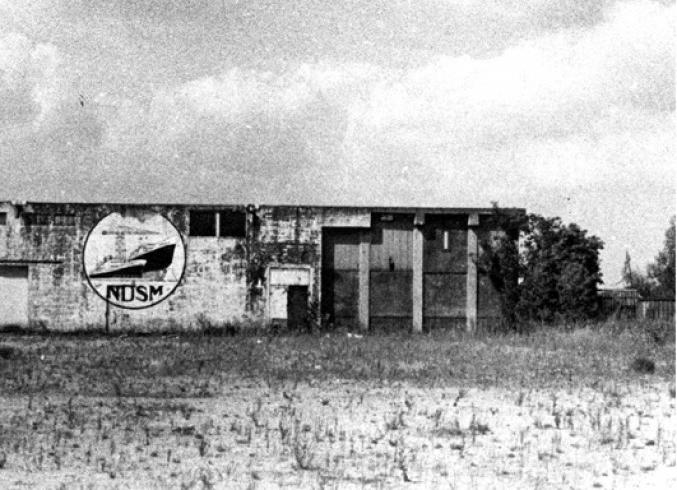
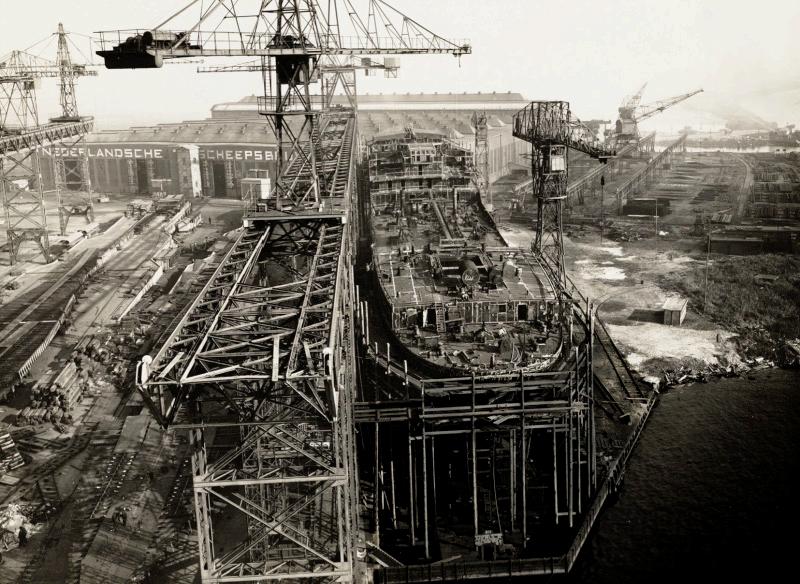

© Mark Van Den Brick Source: http://www. evadeklerk.com/wp-content/uploads/2013/03/ logo-ndsm-op-helling.jpg
Source: http://www. evadeklerk.com/wp-content/uploads/2013/03/ schip-op-helingbaan-kopie.png
© Paul Fennis Source: http://www. evadeklerk.com/wp-content/uploads/2013/03/ NDSM-werf.jpg
Users, Layout, Funding
Make your city, Eva De Klerk The interior planning layout was created mainly based on groups of users and their specific needs. As a result, five clusters of buildings were created which housed the main five categories of end-users:
- Theatre makers, inventors and circus artists - Free plots and people involved with making boats - Skateboarders and the youth cluster - Musicians - Events and exhibitions + Artist studios, Creators, Start-ups and also restaurants
The funding in order to buy, run, maintain and renovate the shipyard came through various sources. The program won awards and prizes from the government for various reasons; the national government’s stimulation prize for innovative city development, another award for the creative and sustainable heating system using heat pipes in the ground, loan,s and the initial investment made by selected users.
Users were chosen based on only two criteria and by the tenants who were involved with the project from the beginning. The two criteria were: applicants who were not able to afford the high market prices and were self-builders since the shipyard would only provide them with a shell and the rest had to be built by each group.
Also, in order to keep the place accessible for as many users as possible, each group could only take a maximum of 100 sqm of space. After all, users who grew and needed more space could move elsewhere.
https://www.dynamoarchitecten.nl/2020/07/06/0105ndsm-studio-city/
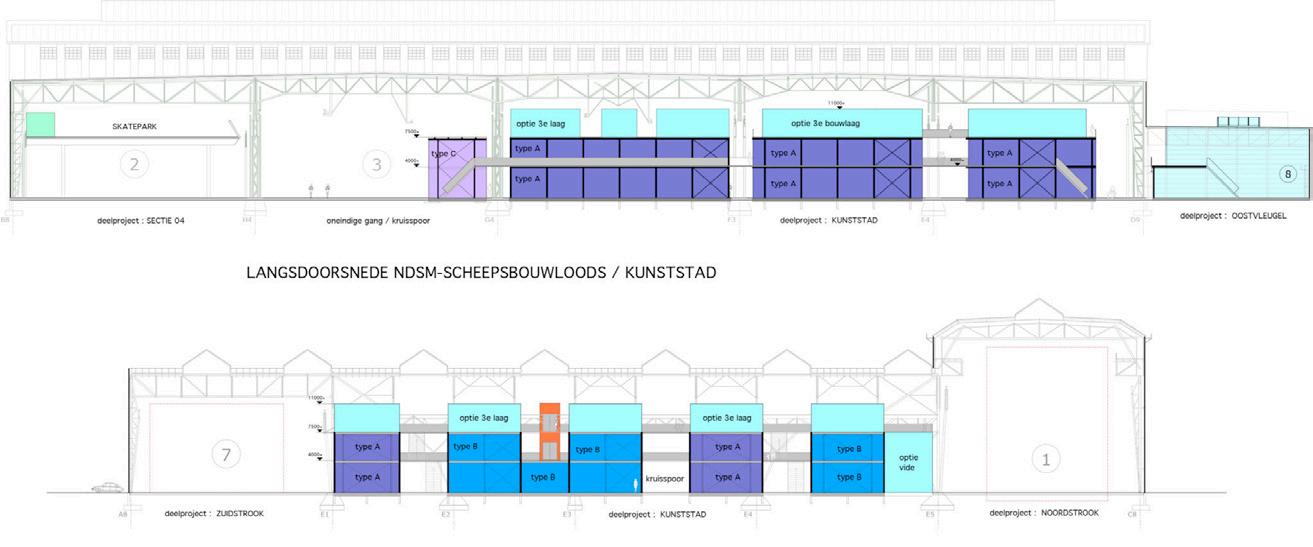
Left: Art City NDSM Sections Drawn by Dynamo Architecten Art City NDSM Photos showing the art city NDSM, the main shipyard occupied by creatives on three scales: Streets, Alleys, and Interiors

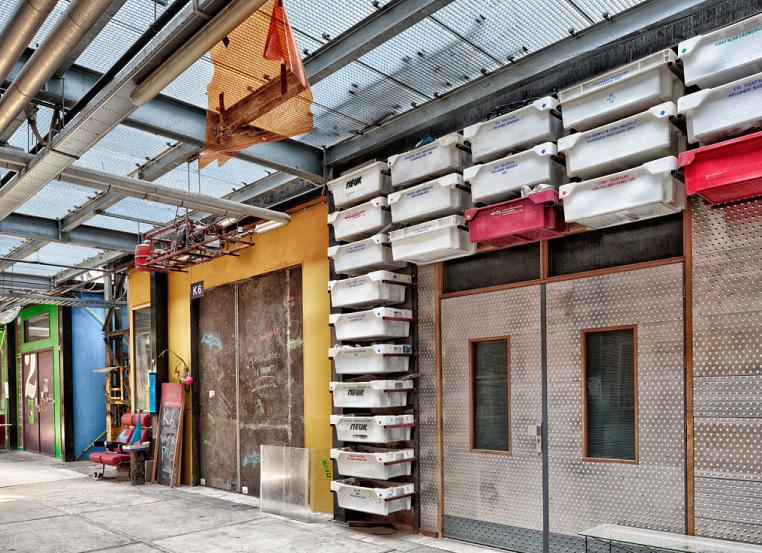
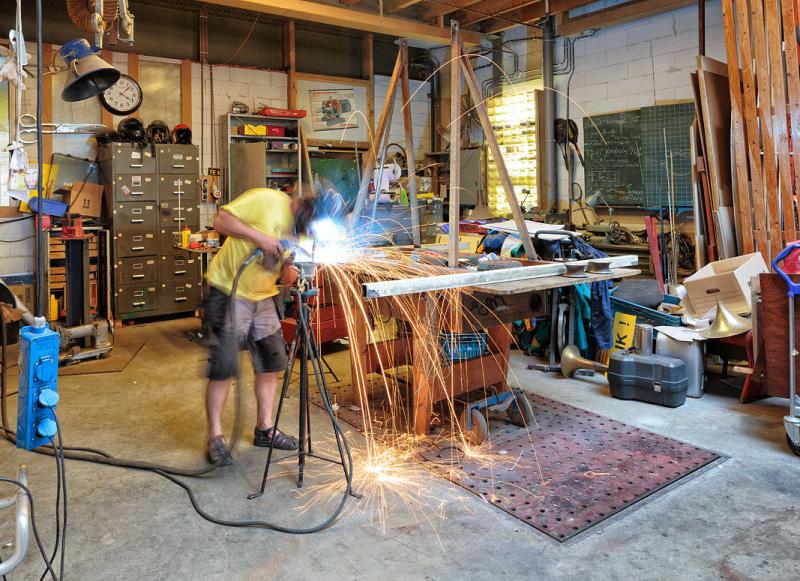
© Johan Lorthioir Source: http://www. evadeklerk.com/wp-content/uploads/2013/03/ Johan-Lorthioir-F-800x600. jpeg
© Ronald Tilleman Source: http://www .evadeklerk.com/w p-content/uploads/ 2013/03/tilleman_20130708-03041800x600.jpg
© Ronald Tilleman Source: http://www. evadeklerk.com/wp -content/uploads/2013/03/ tilleman_20130708-02251 -800x600.jpg
Make your city, Eva De Klerk p. 101-102

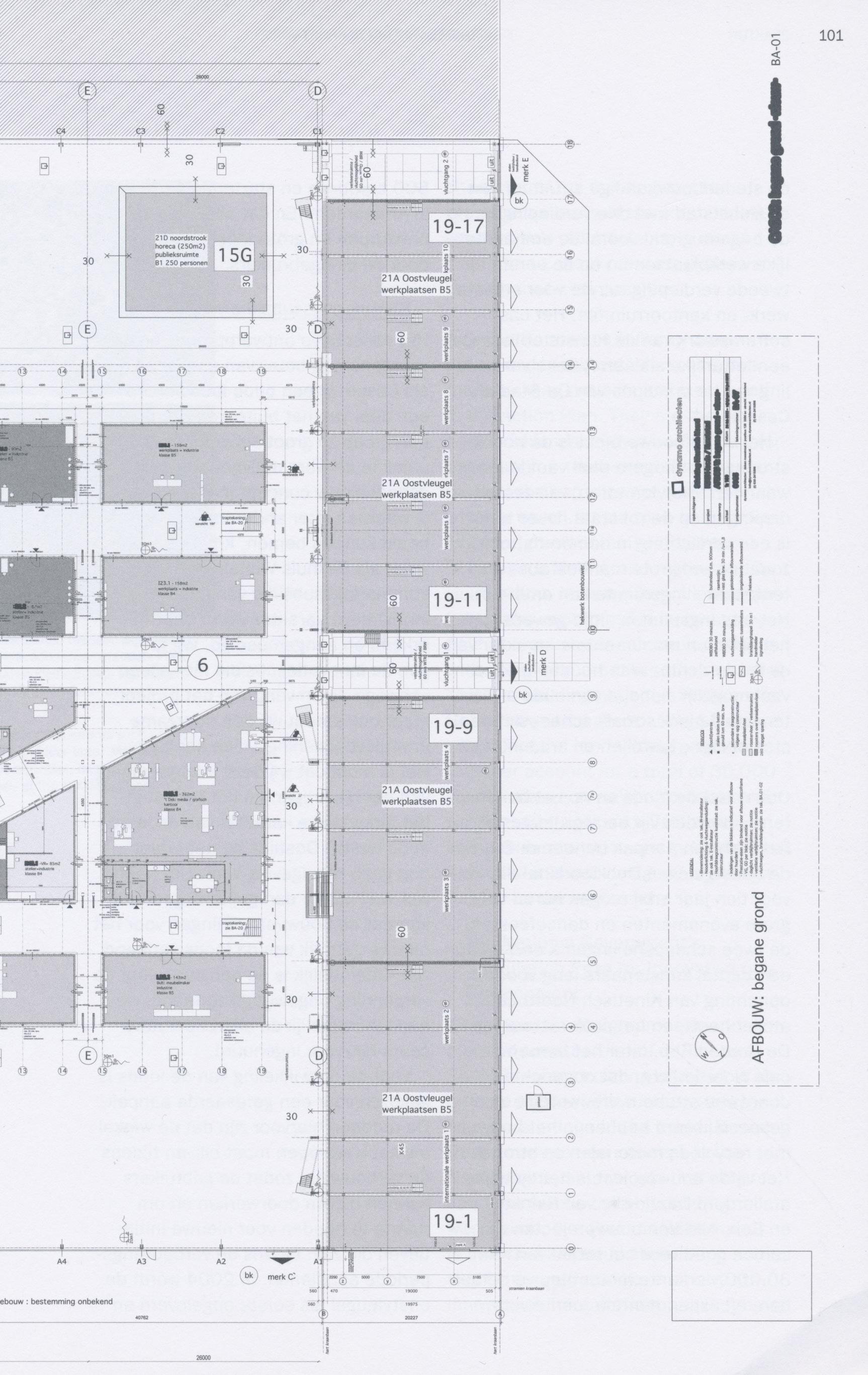
Art City NDSM The legal plan sent to Authorities for confirmation Plans drawn by Dynamo Architecten
Similar Projects, Different Contexts
Tempelhof, Berlin, Germany
The airport was built by the Nazis in 1923 and played an important role in the cold war connecting West Germany and West Berlin. It was located in the center of Berlin and overtime, it has become too small and also too inconvenient for the residents.
As a result, the airport was closed in 2008 as the officials decided to expand Schonefeld airport located outside the city. As a result, an area of 386 acres became empty and the municipality of Berlin started looking for a new initiative. Before its closure, the city organized a workshop to take ideas from different groups. Eventually, the airport was handed over to residents of Berlin.
The complex now includes urban farms, a cafe, a skatepark, and plenty of space for kitesurfing. In 2014, the people of Berlin declared themselves against a new construction plan by Starchitects and demanded the park to remain as a sport and recreation center.
Namura Shipyard, Osaka, Japan
The story behind Namura Shipyard is quite different from the ones on Tempelhof and NDSM. The shipyard has come to a commercial standstill since the 1980s, similar to NDSM.
The site is now owned by a company called Chishima, formerly active in the shipbuilding sector, whereas they now operate as a real estate company and also, aircraft specialists. The property and 80 other similar buildings are all owned by the same company, which currently operates under Mr. Shibakawa.
He supports special projects of the residents and has no plans for special groups to get a hold of the buildings. Residents, including artists and students, are active in projects such as making sheds, warehouses, offices and, even hostels. Since the owner has let the place evolve organically, everything seems to be merging effortlessly.
“There’s an alternative. There’s always a third way, and it’s not a combination of the other two ways. It’s a different way.”
- David Carradine



